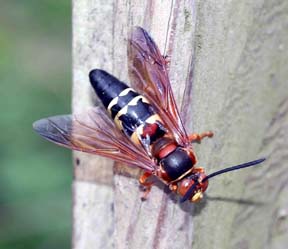Cicada Killer | |
|---|---|
| July 11, 2007 | |
|
Cicada killers are about 2 inches long and black, with yellow bandlike marks. The head and transparent wings are brownish red. These are solitary wasps, the female of which digs a 6- to 10-inch burrow (with a diameter of 1/4 to 1/2 inch) in the ground. These burrows typically have a 3- to 6-inch-diameter mound of fine soil around them. She locates and stings a large insect such as a cicada, drags it to a chamber in the burrow, and lays an egg on it. The female covers up the burrow, digs another one, and repeats the process. The egg hatches into a legless, grublike larva that eats the paralyzed insect, pupates, and emerges the next summer as an adult.  Male wasps establish aerial territories and patrol for intruders. Someone walking into the territory typically is confronted with a large wasp hovering in front of the face, zipping to the side and to the back before leaving. A male cicada killer drives off males entering his territory and tries to mate with female cicada killers that enter. Apparently, after determining an intruder is neither, he ignores the person. Unfortunately, as you walk across a lawn, fairway, or other area where these wasps are nesting, the process is repeated as you walk through each male’s territory. These wasps are unlikely to sting. Wasp and bee stingers are modified egg-laying devices, so males are not equipped to sting. Females sting if crushed, as when stepped on or grabbed by bare hands. |